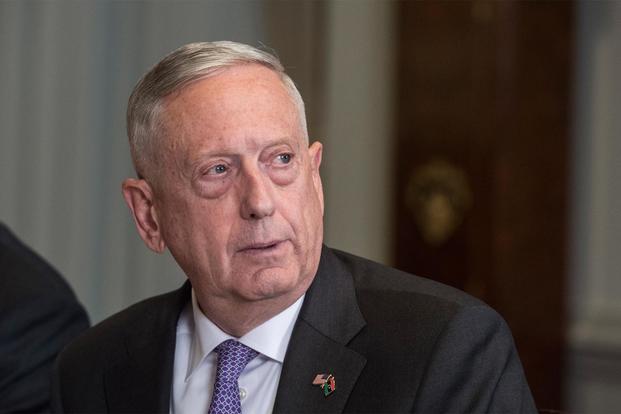U.S.-backed forces were in the process of "crushing the life" out of ISIS but "the war is not over" in Iraq and Syria, Defense Secretary Jim Mattis said Friday.
Iraq declared victory over the Islamic State of Iraq and Syria earlier this month and held a parade in Baghdad. Russian President Vladimir Putin later made similar claims on behalf of the Moscow-backed regime of Syrian President Bashar al-Assad and said -- not for the first time -- that Russia would begin withdrawing troops.
However, Mattis echoed his field commanders in stating that much work remained to be done to prevent the emergence of what Mattis has called "ISIS 2.0," a reference to a possible ISIS attempt to return to its hit-and-run terror roots in an effort to once again exploit sectarian rifts in Iraq and Syria.
"We told you that the [ISIS] caliphate was going to go down," Mattis said, and "as we sit here today at the end of 2017, the caliphate is on the run, we're breaking them."
The string of defeats for ISIS, from Mosul and Kirkuk in Iraq to Raqqa in Syria, was the result of accelerating the strategy put in place by the Obama administration to train, advise and assist partnered forces who would take the lead in the fight backed by U.S. airpower, Mattis said.
Mattis said there were "numerous people who thought that, perhaps, the strategy was wrong when it was initiated by the last administration -- thought it was too slow when I came in."
However, picking up the pace on the basic strategy was "crushing the life" out of ISIS, he said.
Related content:
- Lawmakers Want to Force US Military Out of Yemen War
- Mattis: Middle East Not Just 'One War' for the US
- Mattis: Trump Empowered Commanders to 'Annihilate ISIS'
Mattis said he was not overly concerned that the gains against ISIS in Syria could be jeopardized by disputes over the demarcation, or "deconfliction" lines, in eastern Syria where the U.S.-backed Syrian Democratic Forces [SDF] are in close proximity to Assad's forces backed by Russian airpower.
The U.S. and the SDF were now focused on ISIS' remnants in the Middle Euphrates River Valley, Mattis said. "We recognize that there's a deconfliction line that runs down the river," he said.
He did not give specifics, but said that occasionally "there have been problems" along the deconfliction line between U.S. and Russian forces. "We've resolved those problems," he said.
Referring to the hotlines used by U.S. and Russia to communicate, Mattis said "never once have we called and it's not been answered, never once have they called and we've not answered."
Mattis made the comments in a wide-ranging, year-end session with Pentagon reporters. At one point in the informal back and forth, Mattis bristled at the suggestion in a question that the U.S. was not concerned about civilian casualties in Yemen.
"I'm never okay with any civilian casualties --, don't screw with me on this," Mattis said. He said the U.S. was determined to reduce civilian casualties in the Yemeni civil war pitting tribal Houthi rebels backed by Iran against Saudi-backed forces of the ousted government.
The U.S. has been providing intelligence and air refueling to Saudi fighters that have repeatedly hit the Yemeni capital of Sanaa.
On Thursday, the United Nations issued a report stating that more than 100 civilians had been killed in a series airstrikes in Yemen in the past 10 days.
Mattis said the U.S. was working closely with the Saudis on limiting the civilian casualties. "We are going to continue to train them how to do target identification, try to get their capabilities up in those areas," he said.
"We're going to continue to work with their pilots and explain how you do bombing runs, that sort of thing," Mattis said, while stressing that the Houthis often take positions in residential areas.
"Anything we can do to limit the civilian casualties, we will be doing," he said. "We are going to try to make that military of the Saudis more capable of carrying out what they find to be their military necessity without killing innocents."
Earlier in the session with Pentagon reporters, Mattis said he doubted that ISIS fighters would be able to find a new safe have in Syria, despite reports that many of them were fleeing to the west to areas controlled by other rebel groups near Damascus.
"Those who are fleeing somewhere else -- it's the normal thing that happens" in war, he said. "I'm not seeing right now that there's some concentration where they're going to come up big and have a safe haven. I've not seen any indication of that."
The objective for the U.S. now in both Iraq and Syria was to reduce the ISIS threat to the point that local police can handle it, Mattis said. To do that was still the job of the military backed by accurate intelligence that can pinpoint the locations of scattered groups of fighters, Mattis said.
"What we want to do is drive this down to the point that it can be handled by local authority, by police and that sort of thing," Mattis said, "but right now it's still very much a military/intelligence operation."
-- The second graph was updated to correct the name of Syria's president.
-- Richard Sisk can be reached at Richard.Sisk@Military.com.













